Imre Madách was born in the castle of the Madách Family, in Alsósztregova (today's Dolná Strehová, Slovakia), Nógrád County, on 21 January 1823, 200 years ago (the settlement was annexed to Czechoslovakia with the Trianon decision). He completed his studies privately. His mother, Anna Majtényi, who became a widow at a young age, sent her son to the capital to study law. Imre moved to Pest in 1837, where his younger brothers later followed. According to research, the house was located at today's 1 Kálvin Square. The mother assigned a cook and a servant to her sons and arranged a whole small household for them. Imre Madách's correspondence with her mother shows that her mother spent short periods in Pest with her children.
Madách was not satisfied with the household. "What you thought was the best is the worst. Because a large piece of bacon and two pieces of sugar cane honey were found in the landlady's chest. She stays out until eleven o'clock at night," he wrote to his mother on 15 October 1837. It is known from the correspondence that the woman replaced the housekeeper with another landlady in December of that year. From an exchange of letters, it can be also learnt that on one occasion the turkey sent from Sztregova to Pest froze on the way. "Everything is on the agenda, there is nothing in the pantry," the boy complained.
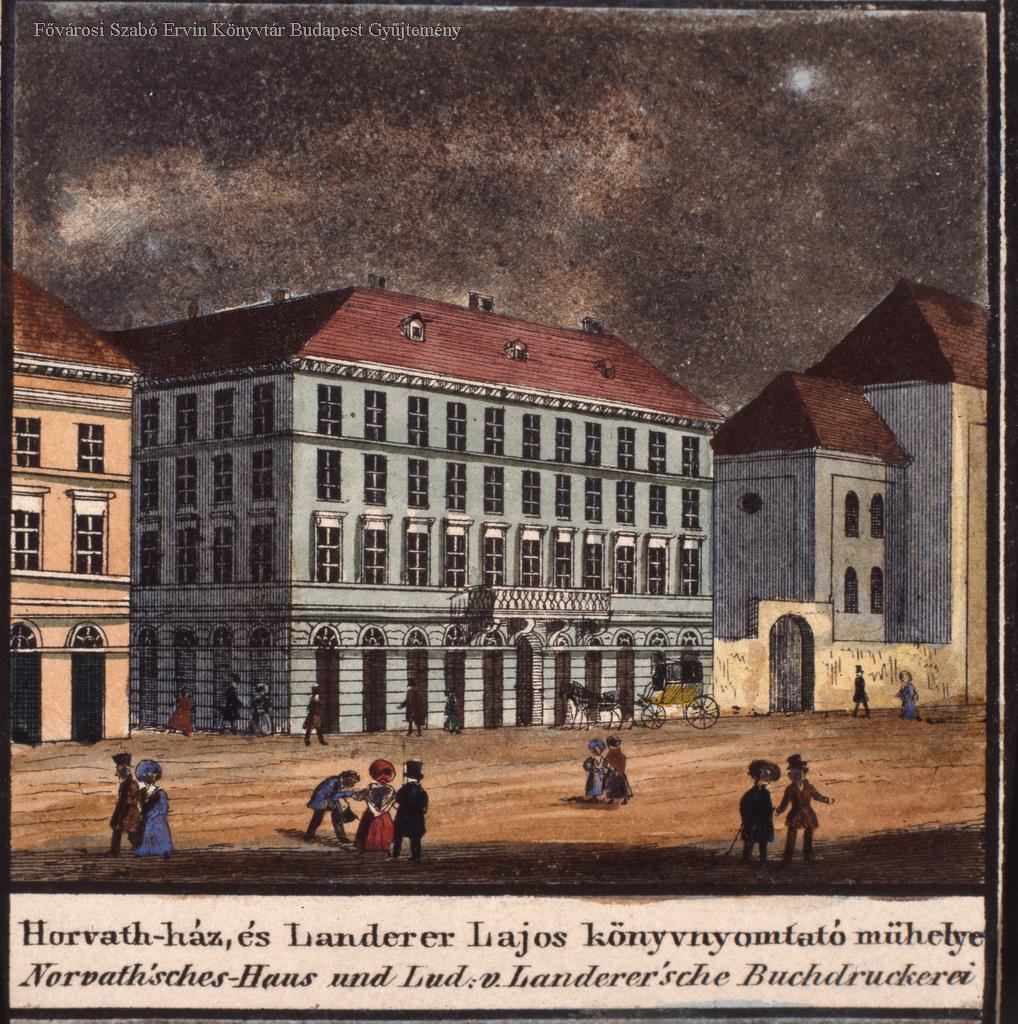
Carl Vasquez's 1837 drawing of the future museum (Source: FSZEK Budapest Collection)
And what could 14-year-old Imre Madách see in today's Kálvin Square area? The Hay market (Heumarkt) operated in this place. As one of the gates of the Pest city wall, the Kecskemét Gate, used to be here, several roads from the Alföld led here, providing an excellent fairground for the farmers coming from the countryside.
The year of his arrival, in 1837, the construction of the National Museum began on the site of Count Antal Batthyány's palace based on Mihály Pollack's plans. Since the first hoes were cut on 22 June 1837, and the walls were already being laid on 3 July, the young Madách could have witnessed the works.
The Reformed church already stood on the square, the construction of which began in 1816 and was completed in 1830 based on the plans of Vince Hild and József Hofrichter and was later rebuilt according to the plans of József Hild, after the flood of 1838 caused serious damage to it. Next to it, based on the plans of the engineer Antal Balla, a one-story house was built in 1804, with a prayer room and a classroom on the ground floor, the pastor's home. (The house was later replaced by the Kálvin Square department store.)
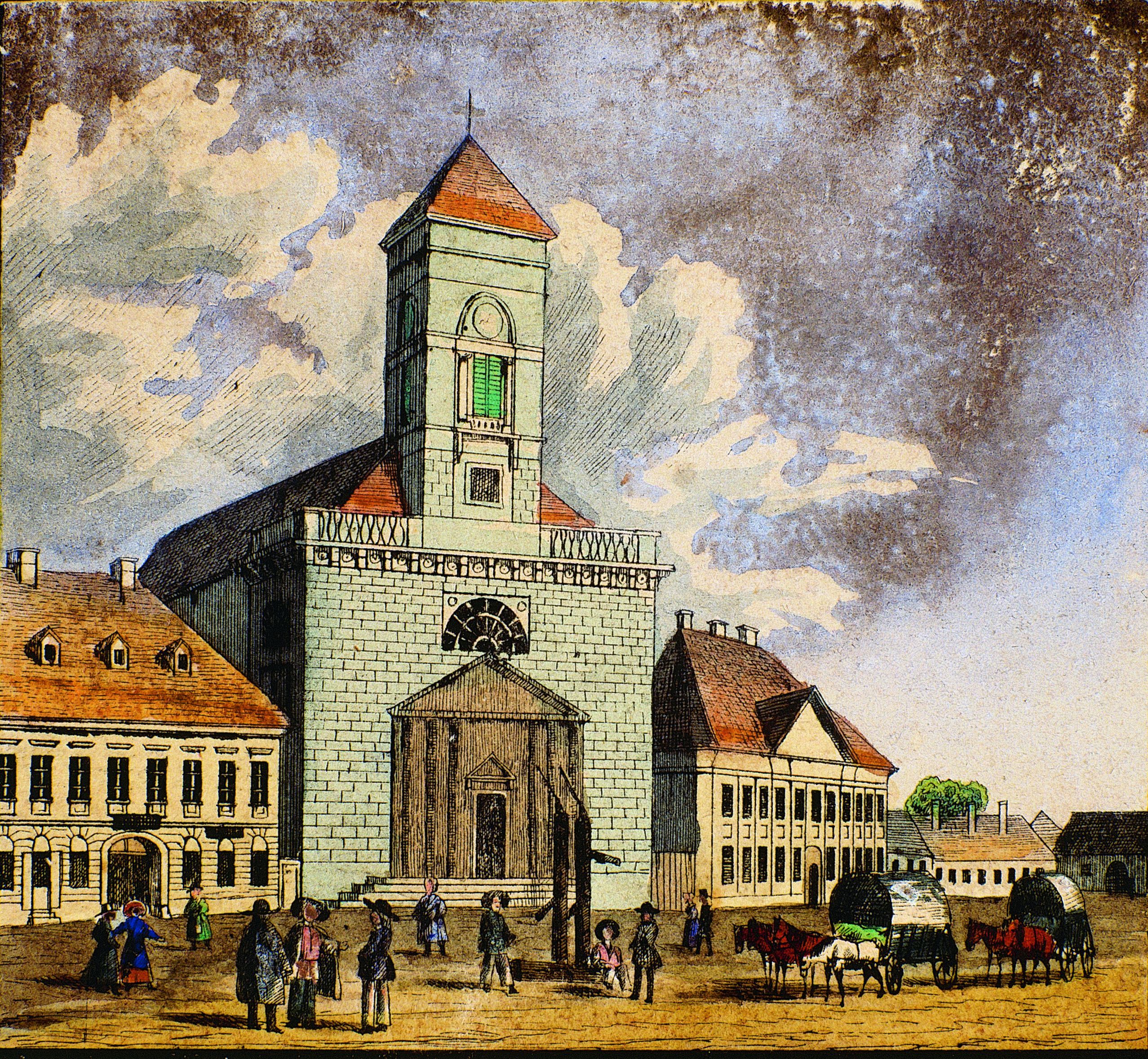
The Kálvin Square Reformed church, on the right is the house designed by Antal Balla in Carl Vasquez's drawing dated 1837 (Source: Ferencváros Local History Collection)
Madách, who spoke six languages (German, French, Slovak, English, Latin, Ancient Greek), studied humanities in the first two semesters and then law from the third at the University of Pest. Among his classmates were two future prime ministers, Count Gyula Andrássy and Menyhért Lónyay. He was interested in the famous poets of the time, and also subscribed to the Athenaeum.
Madách's friend during his university years was Menyhért Lónyay, he founded the Company of The Eight (Nyolczak társasága). This circle was also important for Madách's career because its members read patriotic poems and writings in Hungarian. Its members were the two brothers, Menyhért and Albert Lónyay, Count Gyula Andrássy and his brother Manó, Baron Antal Balassa, Rudolf Boronkay, Ödön Beniczky and Imre Madách. Later, István Kazinczy, Ferenc Lónyay, Sándor Jekelfalussy joined the company. The young people also edited a manuscript paper, which was Mixtura.
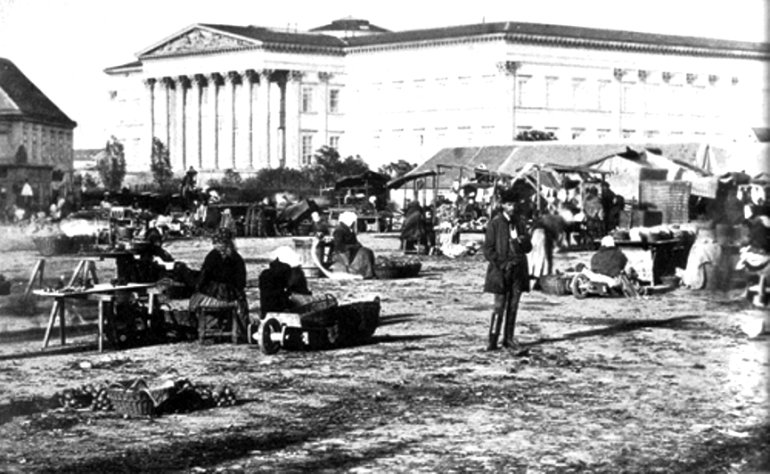
Today's Kálvin Square in the second half of the 19th century. The Hay market operated here (Source: oszk.hu)
Madách already learned to play the piano at home, and he did not neglect his musical studies in Pest either. He also enjoyed going to concerts. And his mother sent extra pocket money for concert tickets. The young people regularly attended the musical performances of the National Casino, which at that time still lacked a permanent location, so it operated in the Lloyd Palace in Pest, on the south side of today's Széchenyi Square, on the site of the Sofitel Hotel. The plans of the classicist-style building were drawn up by József Hild. Palatine Joseph laid the foundation stone on 4 June 1828. From 1830 to 1851, the building housed Széchenyi's Pest Casino, later the National Casino. Classical music events were also held in its large hall. Madách and his company never missed these performances. The two-story palace was severely damaged during World War II and was demolished in 1948.
"We should not expect adventures from our young people. They breathe the air of spiritual purity, they are lifted by the fresh current of the enthusiastic public life of the thirties and forties, they are captivated by their noble ambition, which results in the multifaceted development of individual talents in mutual friction. As pure as their other artistic pleasures, they also had theatrical pleasures, of which, if not too much, they took their fair share," wrote Menyhért Palágyi in his book Life and Poetry of Imre Madách.
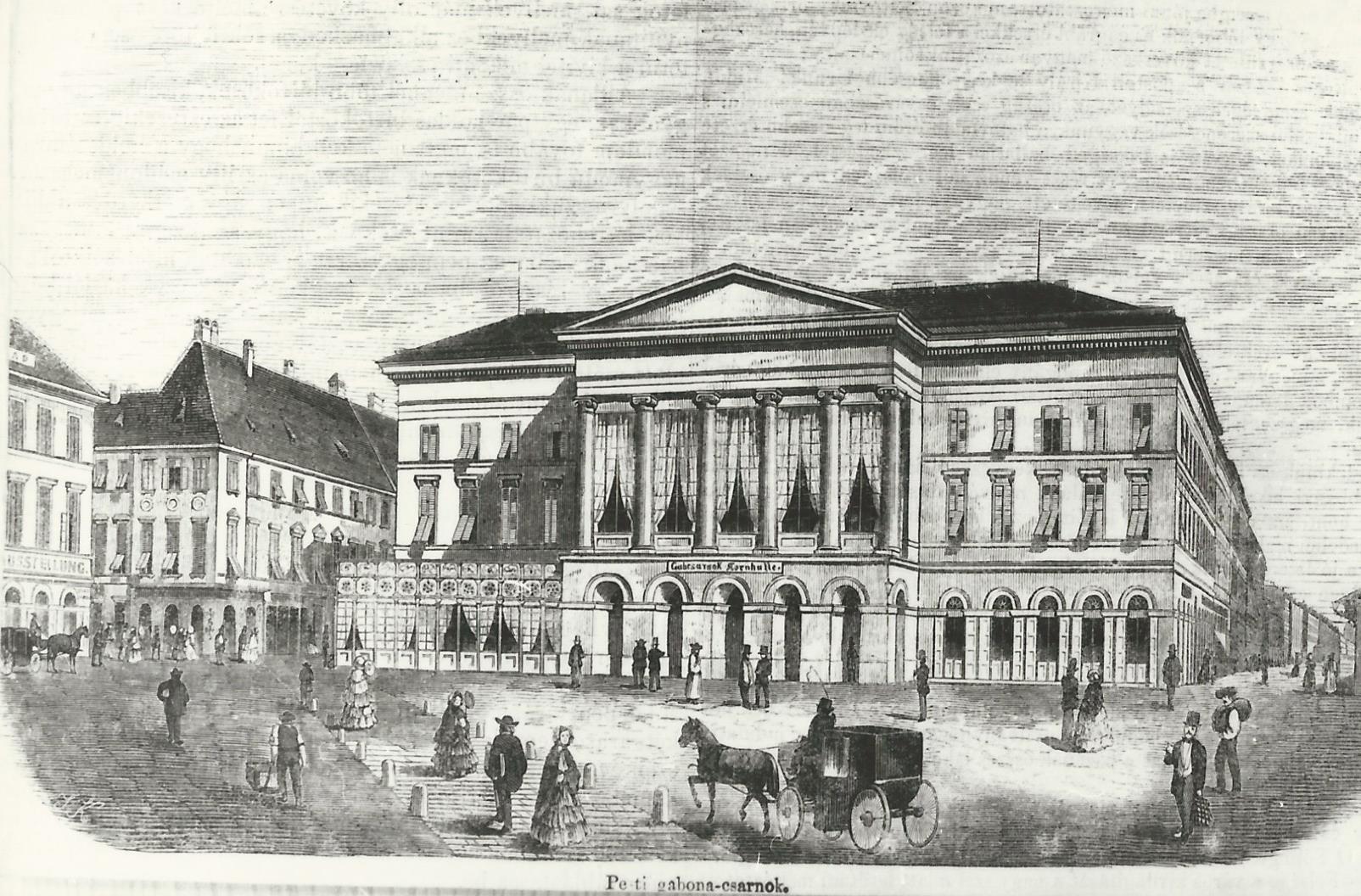
Imre Madách often visited the concerts organised in the Lloyd Palace in Pest (Source: mandab.hu/Hungarian Museum of Trade and Tourism).
The entertainments of Madách and his friends were as follows: "[…] we did not know cards, bowling, we did not enter a coffee house; fencing, swimming, horseback riding, walks, trips to the mountains of Buda: these were our entertainments," wrote Lónyay later. Anna Majtényi feared for his son in the Pest life, for example, in January 1838 she wrote to him not to go out into the street at night. His son replied that he could not fulfil her wish because he comes home from his teacher every day after 6 o'clock. It is hardly known today which teacher he was thinking of, since Madách took many private lessons, learned to draw and paint in addition to the piano, and went to fencing in Pest. In addition, adapting to the aristocratic fashion of the time, he also mastered woodturning. (Perhaps this is also why Michelangelo's words appear in the Falanszter scene: "Yes, because I always made chair legs, And that too for the meanest figure.")
Also in the year of his move to Pest, on 22 August 1837, the capital's first Hungarian-language theatre, the Hungarian Theatre of Pest, was opened, three years later it was the National Theatre at today's 3 Rákóczi Road (Kerepesi Road until 1906). The classicist building was built from a public donation, the plans were drawn up by the chief architect of Pest, Mátyás Zittarbarth, reworking the plans of György Telepy.
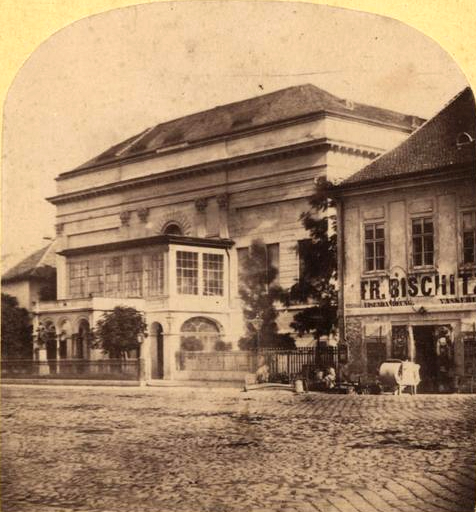
The building of the old National Theatre in 1864 at 3 Kerepesi Road (now Rákóczi Road) Photo: FSZEK Budapest Collection)
The young people's parents usually kept up a box for them in the theatre. About life in the theatre, Madách wrote to his mother: "Although I feel the good influence of the theatre on my career as a writer (because I write such poems that Lónyay and Spetykó strongly want to exhibit them in the Athenaeum, and even a play that Földváry encouraged me to perform), but I do not want to go at your expense, that even if my passions were the greatest, I would give them up for your sake. I can give everything up. Anyway, I still have time. And you know, if I see that it is not good for my brothers to receive something, I do not want to receive it myself. I have one goal only for me, to keep your love and get your satisfaction."
At this time, Imre Madách was already writing poems and plays. His first poem was published in Honművészet, followed by his first book entitled Lant-virágok [Lute-flowers] in the summer of 1840. He addressed most of the 26 poems to his love, Etelka Lónyay.
The Pest years lasted only three years for him. In 1840, Imre Madách and his brothers left the capital. This was partially due to health reasons, as Imre was already being treated for severe gout, but conflicts with employees also justified his departure. He completed his legal studies privately. He became a legal trainee in Balassagyarmat, then became known as a sub-registrar and speaker of the opposition in the county.
In 1845, he married Erzsébet Fráter, and he and his family lived on the Csesztve estate until their marriage broke down. Meanwhile, he wrote continuously. In 1843, he submitted the drama Férfi és Nő [Man and Woman] and Csák végnapjai [The Last Days of Csák] to the drama competition of the Hungarian Academy of Sciences, but they did not win a prize.
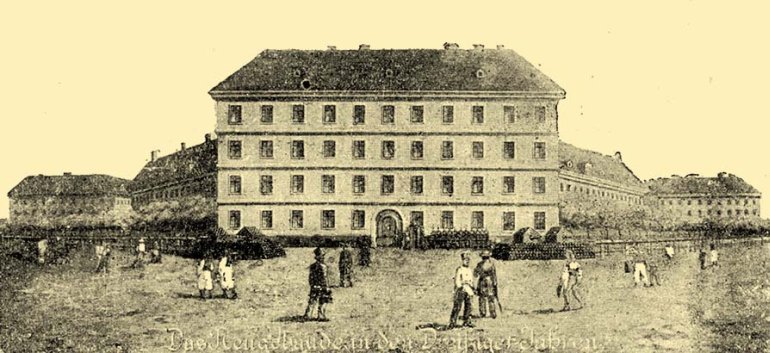
The New Building in the 1850s. Imre Madách was imprisoned here (Source: oszk.hu)
He did not stay in Pest for a long time. After meeting Lajos Kossuth's secretary in Pest in December 1851, the condemned János Rákóczy, whom he took to Csesztve, he was arrested in August 1852 for hiding Rákóczy. First, he was taken to Balassagyarmat, then to Bratislava, and finally, in January 1853 he was transferred to Pest. He was imprisoned in the huge New Building on the site of today's Szabadság Square. Madách began writing his first draft of The Tragedy of Man titled Lucifer, in prison. He was only able to return home to Csesztve in August of that year, where he worked continuously. He finally wrote the Tragedy from 17 February 1859 and finished it on 26 March 1860.
He returned to Pest to participate in the first parliament that opened on 6 April 1861 as a representative of the Balassagyarmat electoral district. Although literary history has no irrefutable proof that he visited János Arany, based on indirect data, it is very likely that he personally handed over the manuscript of the Tragedy to Arany. According to Madách researcher Ferenc Kerényi, it is also probable that the meeting took place on 5 June 1861, after Madách's highly successful speech to the Parliament. The news soon spread in the press that a masterpiece would soon be published. The Tragedy of Man was published on 12 January 1862 by the Kisfaludy Society. After that, Madách lived for another two years. He died young, at the age of 41, on 5 October 1864, of heart failure.
Cover photo: Imre Madách (pim.hu)

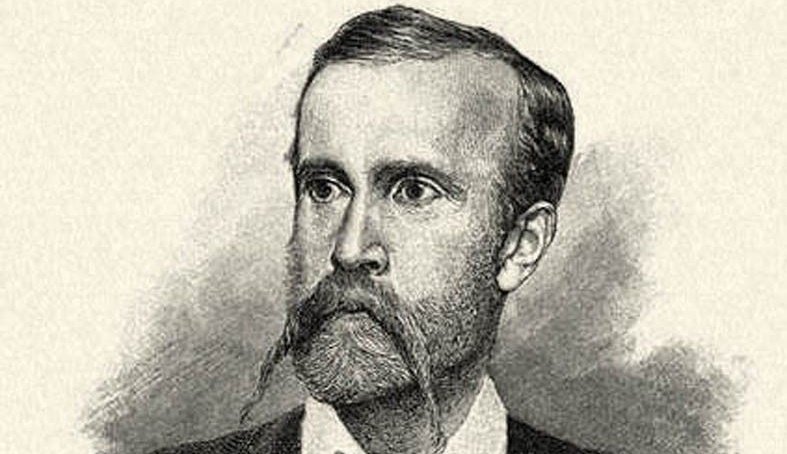
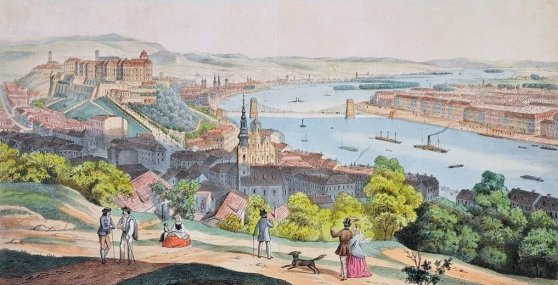





Hozzászólások
Log in or register to comment!
Login Registration